Managing Health and Safety in Own Area of Facilities Management Report
VerifiedAdded on 2023/01/11
|19
|7469
|48
Report
AI Summary
This report delves into the crucial aspects of health and safety within facilities management, addressing the legal requirements imposed by the Health and Safety at Work Act (HSW Act), emphasizing the 'Duty of Care' for employers, employees, and suppliers. It explains the 'Six Pack' of health and safety regulations, including the Management of Health and Safety at Work Regulations, Display Screen Equipment Regulations, and others, highlighting their significance. The report outlines the minimum legal requirements of the Management of Health and Safety at Work Regulations 1999 and emphasizes the importance of effective health and safety management in the workplace, alongside the responsibilities of various organizational roles. It further identifies relevant health and safety legislation, regulations, and codes of practice, such as the Health and Safety at Work Act 1974, RIDDOR, and the Regulatory Reform Order (For Fire Safety), explaining their practical applications. The report also discusses the actions available to health and safety inspectors for enforcing legislation and the personal responsibilities and liabilities of individuals, particularly the CEO, in ensuring workplace safety, emphasizing the need for compliance with health and safety legislation and the proactive implementation of safety policies.
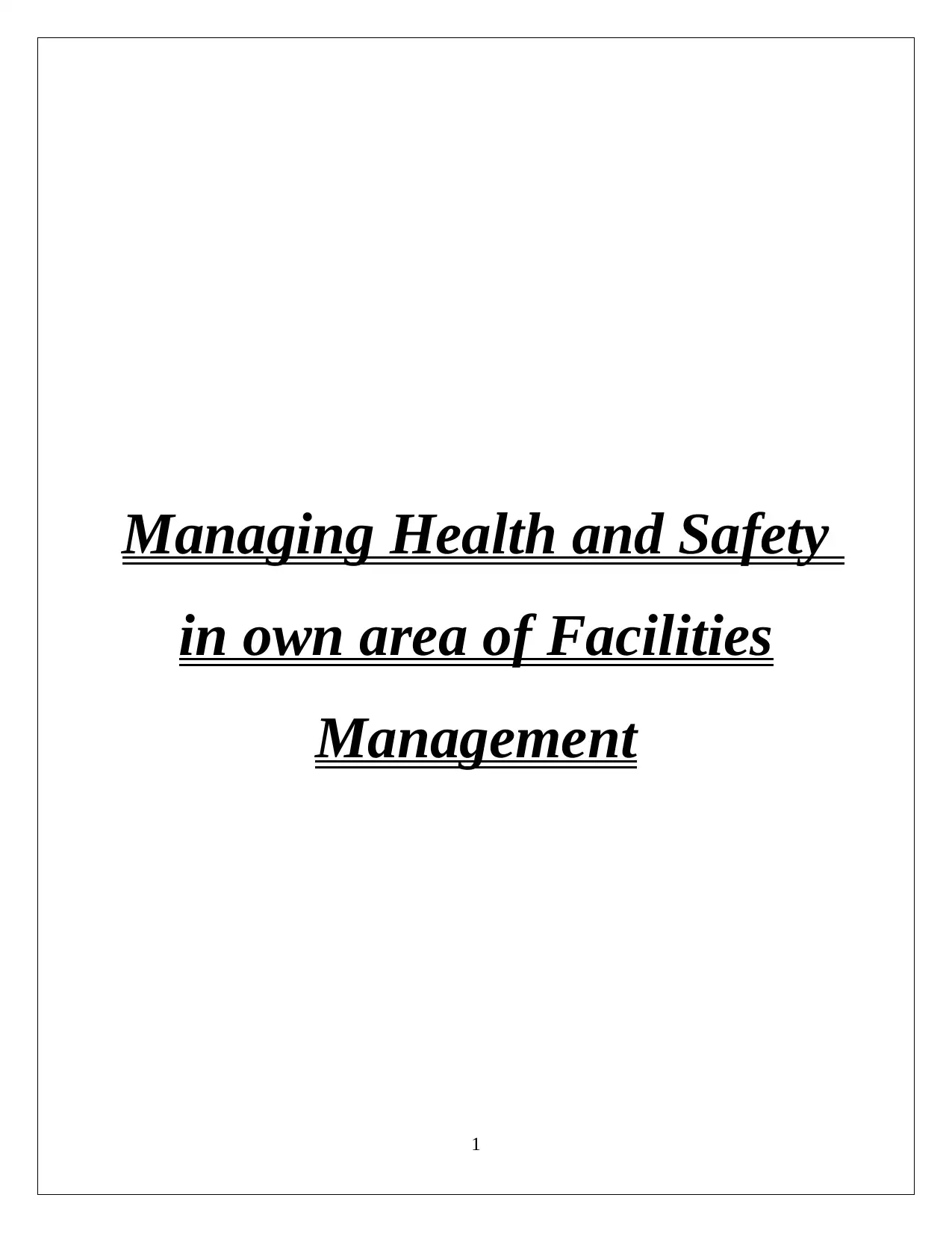
Managing Health and Safety
in own area of Facilities
Management
1
in own area of Facilities
Management
1
Paraphrase This Document
Need a fresh take? Get an instant paraphrase of this document with our AI Paraphraser
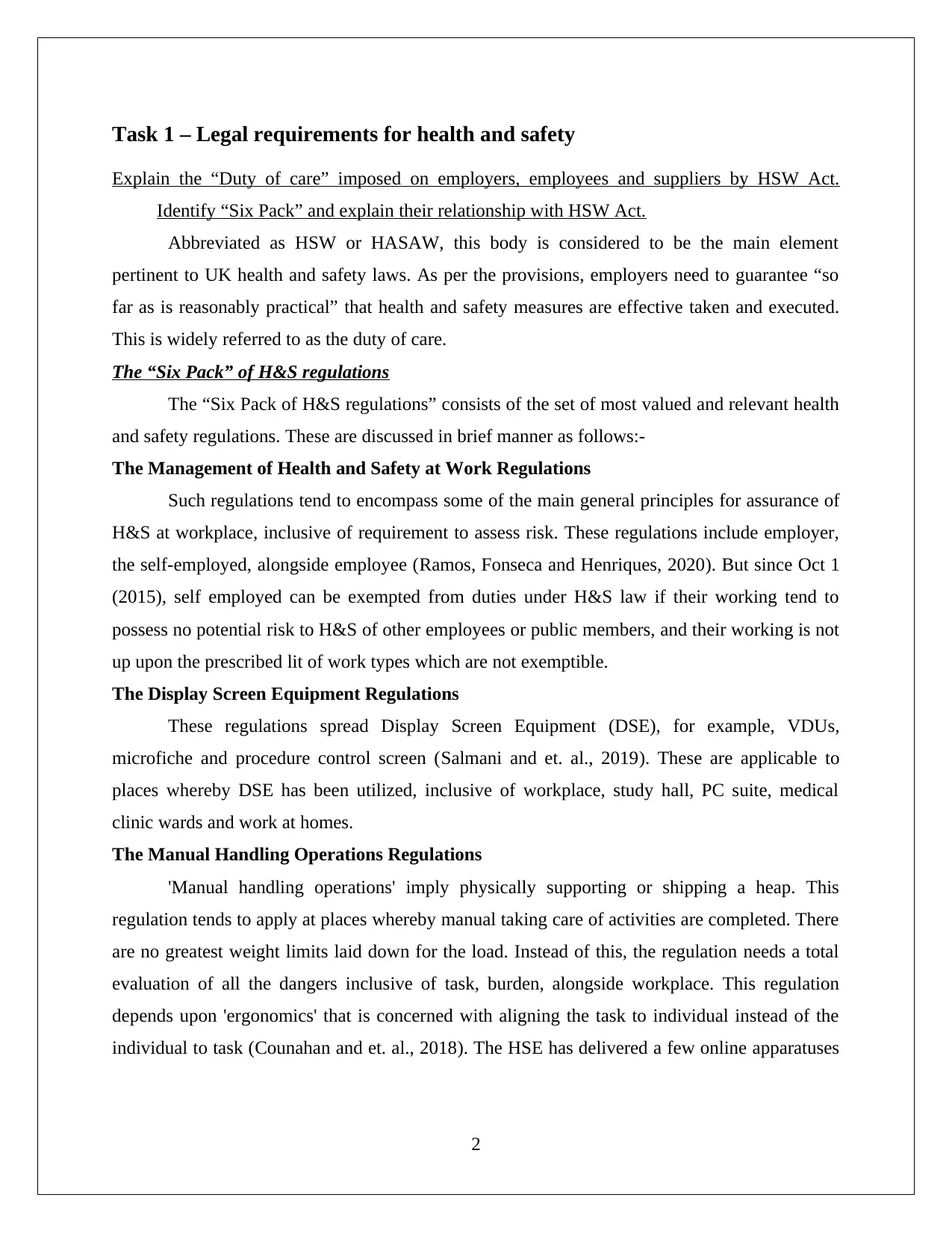
Task 1 – Legal requirements for health and safety
Explain the “Duty of care” imposed on employers, employees and suppliers by HSW Act.
Identify “Six Pack” and explain their relationship with HSW Act.
Abbreviated as HSW or HASAW, this body is considered to be the main element
pertinent to UK health and safety laws. As per the provisions, employers need to guarantee “so
far as is reasonably practical” that health and safety measures are effective taken and executed.
This is widely referred to as the duty of care.
The “Six Pack” of H&S regulations
The “Six Pack of H&S regulations” consists of the set of most valued and relevant health
and safety regulations. These are discussed in brief manner as follows:-
The Management of Health and Safety at Work Regulations
Such regulations tend to encompass some of the main general principles for assurance of
H&S at workplace, inclusive of requirement to assess risk. These regulations include employer,
the self-employed, alongside employee (Ramos, Fonseca and Henriques, 2020). But since Oct 1
(2015), self employed can be exempted from duties under H&S law if their working tend to
possess no potential risk to H&S of other employees or public members, and their working is not
up upon the prescribed lit of work types which are not exemptible.
The Display Screen Equipment Regulations
These regulations spread Display Screen Equipment (DSE), for example, VDUs,
microfiche and procedure control screen (Salmani and et. al., 2019). These are applicable to
places whereby DSE has been utilized, inclusive of workplace, study hall, PC suite, medical
clinic wards and work at homes.
The Manual Handling Operations Regulations
'Manual handling operations' imply physically supporting or shipping a heap. This
regulation tends to apply at places whereby manual taking care of activities are completed. There
are no greatest weight limits laid down for the load. Instead of this, the regulation needs a total
evaluation of all the dangers inclusive of task, burden, alongside workplace. This regulation
depends upon 'ergonomics' that is concerned with aligning the task to individual instead of the
individual to task (Counahan and et. al., 2018). The HSE has delivered a few online apparatuses
2
Explain the “Duty of care” imposed on employers, employees and suppliers by HSW Act.
Identify “Six Pack” and explain their relationship with HSW Act.
Abbreviated as HSW or HASAW, this body is considered to be the main element
pertinent to UK health and safety laws. As per the provisions, employers need to guarantee “so
far as is reasonably practical” that health and safety measures are effective taken and executed.
This is widely referred to as the duty of care.
The “Six Pack” of H&S regulations
The “Six Pack of H&S regulations” consists of the set of most valued and relevant health
and safety regulations. These are discussed in brief manner as follows:-
The Management of Health and Safety at Work Regulations
Such regulations tend to encompass some of the main general principles for assurance of
H&S at workplace, inclusive of requirement to assess risk. These regulations include employer,
the self-employed, alongside employee (Ramos, Fonseca and Henriques, 2020). But since Oct 1
(2015), self employed can be exempted from duties under H&S law if their working tend to
possess no potential risk to H&S of other employees or public members, and their working is not
up upon the prescribed lit of work types which are not exemptible.
The Display Screen Equipment Regulations
These regulations spread Display Screen Equipment (DSE), for example, VDUs,
microfiche and procedure control screen (Salmani and et. al., 2019). These are applicable to
places whereby DSE has been utilized, inclusive of workplace, study hall, PC suite, medical
clinic wards and work at homes.
The Manual Handling Operations Regulations
'Manual handling operations' imply physically supporting or shipping a heap. This
regulation tends to apply at places whereby manual taking care of activities are completed. There
are no greatest weight limits laid down for the load. Instead of this, the regulation needs a total
evaluation of all the dangers inclusive of task, burden, alongside workplace. This regulation
depends upon 'ergonomics' that is concerned with aligning the task to individual instead of the
individual to task (Counahan and et. al., 2018). The HSE has delivered a few online apparatuses
2
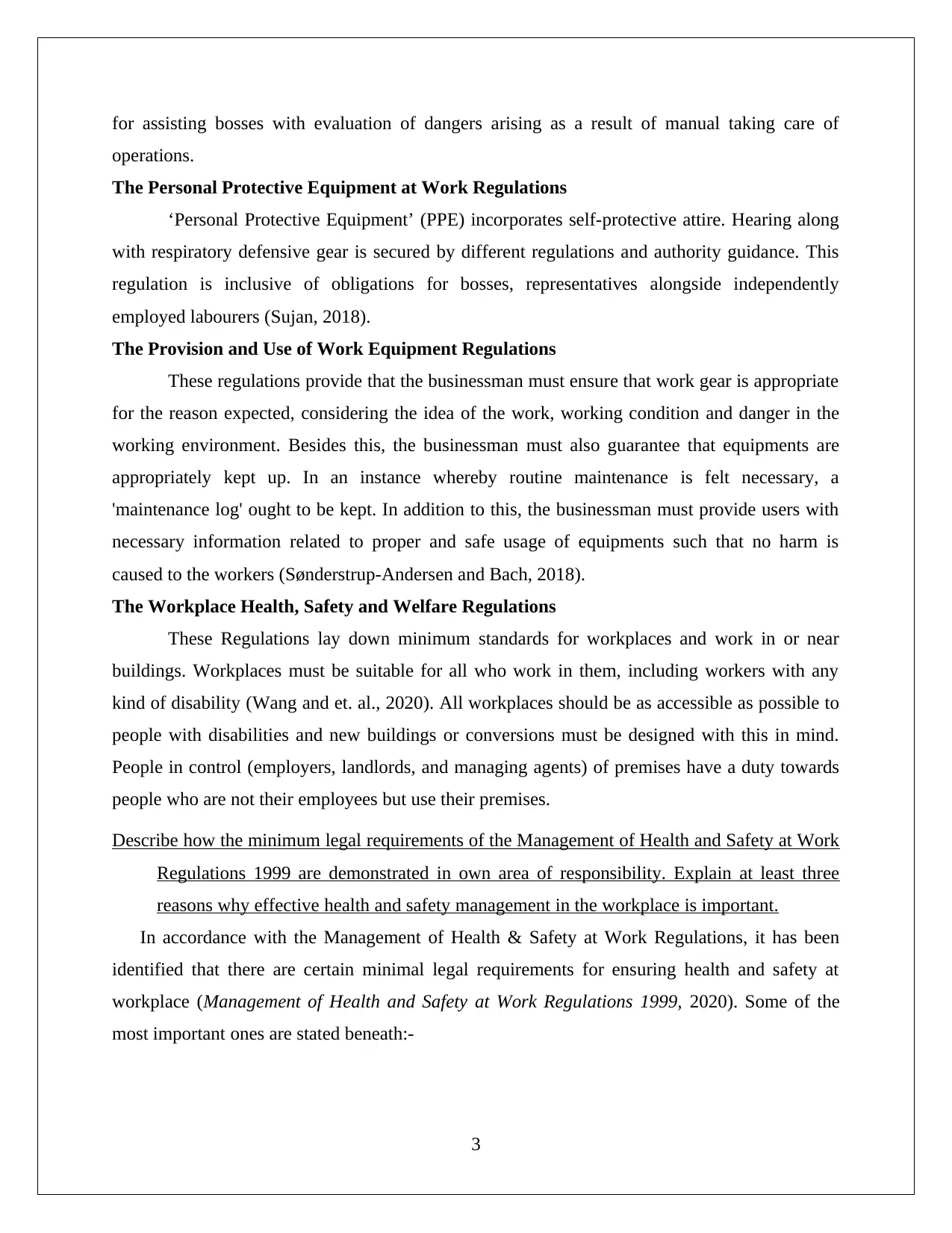
for assisting bosses with evaluation of dangers arising as a result of manual taking care of
operations.
The Personal Protective Equipment at Work Regulations
‘Personal Protective Equipment’ (PPE) incorporates self-protective attire. Hearing along
with respiratory defensive gear is secured by different regulations and authority guidance. This
regulation is inclusive of obligations for bosses, representatives alongside independently
employed labourers (Sujan, 2018).
The Provision and Use of Work Equipment Regulations
These regulations provide that the businessman must ensure that work gear is appropriate
for the reason expected, considering the idea of the work, working condition and danger in the
working environment. Besides this, the businessman must also guarantee that equipments are
appropriately kept up. In an instance whereby routine maintenance is felt necessary, a
'maintenance log' ought to be kept. In addition to this, the businessman must provide users with
necessary information related to proper and safe usage of equipments such that no harm is
caused to the workers (Sønderstrup-Andersen and Bach, 2018).
The Workplace Health, Safety and Welfare Regulations
These Regulations lay down minimum standards for workplaces and work in or near
buildings. Workplaces must be suitable for all who work in them, including workers with any
kind of disability (Wang and et. al., 2020). All workplaces should be as accessible as possible to
people with disabilities and new buildings or conversions must be designed with this in mind.
People in control (employers, landlords, and managing agents) of premises have a duty towards
people who are not their employees but use their premises.
Describe how the minimum legal requirements of the Management of Health and Safety at Work
Regulations 1999 are demonstrated in own area of responsibility. Explain at least three
reasons why effective health and safety management in the workplace is important.
In accordance with the Management of Health & Safety at Work Regulations, it has been
identified that there are certain minimal legal requirements for ensuring health and safety at
workplace (Management of Health and Safety at Work Regulations 1999, 2020). Some of the
most important ones are stated beneath:-
3
operations.
The Personal Protective Equipment at Work Regulations
‘Personal Protective Equipment’ (PPE) incorporates self-protective attire. Hearing along
with respiratory defensive gear is secured by different regulations and authority guidance. This
regulation is inclusive of obligations for bosses, representatives alongside independently
employed labourers (Sujan, 2018).
The Provision and Use of Work Equipment Regulations
These regulations provide that the businessman must ensure that work gear is appropriate
for the reason expected, considering the idea of the work, working condition and danger in the
working environment. Besides this, the businessman must also guarantee that equipments are
appropriately kept up. In an instance whereby routine maintenance is felt necessary, a
'maintenance log' ought to be kept. In addition to this, the businessman must provide users with
necessary information related to proper and safe usage of equipments such that no harm is
caused to the workers (Sønderstrup-Andersen and Bach, 2018).
The Workplace Health, Safety and Welfare Regulations
These Regulations lay down minimum standards for workplaces and work in or near
buildings. Workplaces must be suitable for all who work in them, including workers with any
kind of disability (Wang and et. al., 2020). All workplaces should be as accessible as possible to
people with disabilities and new buildings or conversions must be designed with this in mind.
People in control (employers, landlords, and managing agents) of premises have a duty towards
people who are not their employees but use their premises.
Describe how the minimum legal requirements of the Management of Health and Safety at Work
Regulations 1999 are demonstrated in own area of responsibility. Explain at least three
reasons why effective health and safety management in the workplace is important.
In accordance with the Management of Health & Safety at Work Regulations, it has been
identified that there are certain minimal legal requirements for ensuring health and safety at
workplace (Management of Health and Safety at Work Regulations 1999, 2020). Some of the
most important ones are stated beneath:-
3
⊘ This is a preview!⊘
Do you want full access?
Subscribe today to unlock all pages.

Trusted by 1+ million students worldwide
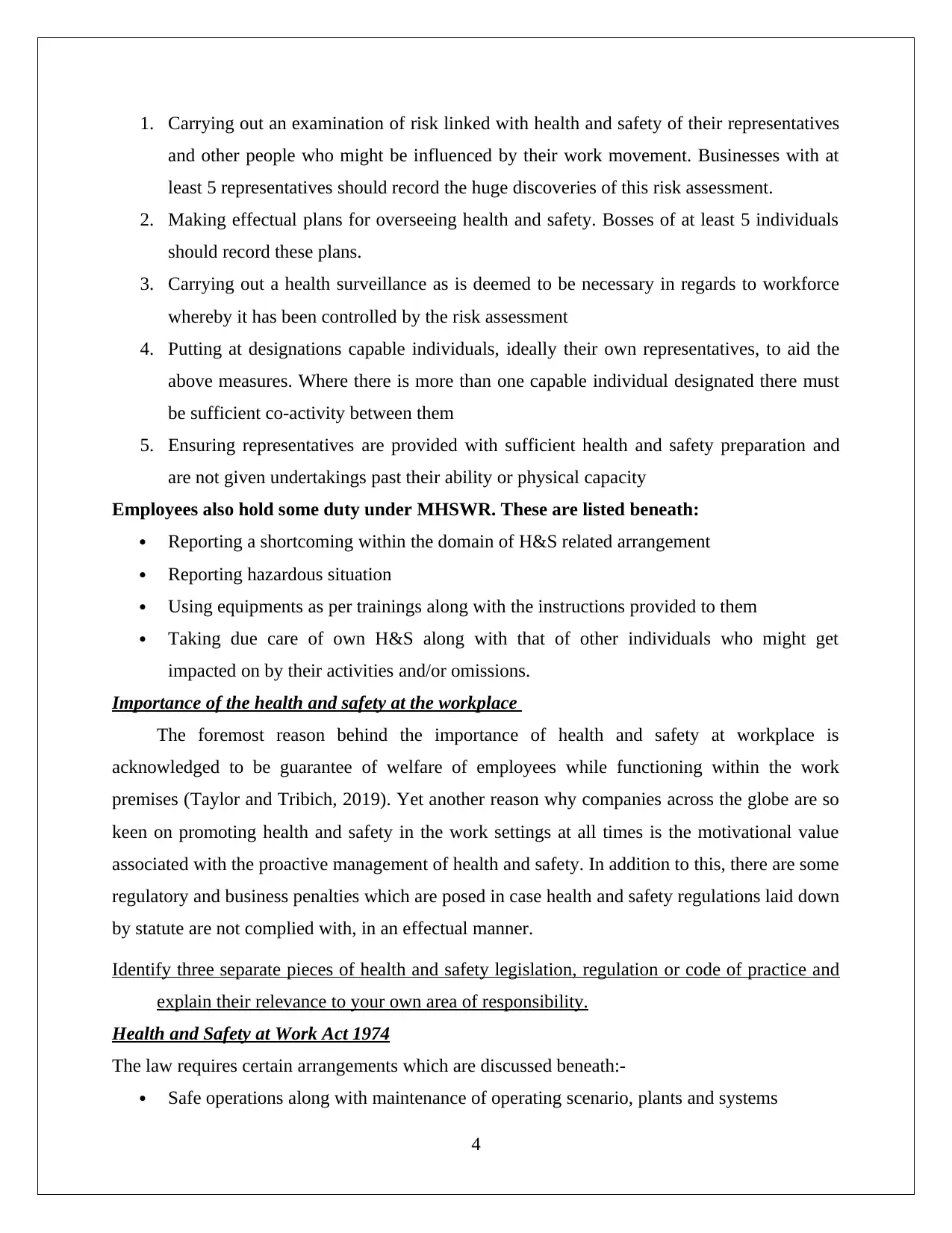
1. Carrying out an examination of risk linked with health and safety of their representatives
and other people who might be influenced by their work movement. Businesses with at
least 5 representatives should record the huge discoveries of this risk assessment.
2. Making effectual plans for overseeing health and safety. Bosses of at least 5 individuals
should record these plans.
3. Carrying out a health surveillance as is deemed to be necessary in regards to workforce
whereby it has been controlled by the risk assessment
4. Putting at designations capable individuals, ideally their own representatives, to aid the
above measures. Where there is more than one capable individual designated there must
be sufficient co-activity between them
5. Ensuring representatives are provided with sufficient health and safety preparation and
are not given undertakings past their ability or physical capacity
Employees also hold some duty under MHSWR. These are listed beneath:
Reporting a shortcoming within the domain of H&S related arrangement
Reporting hazardous situation
Using equipments as per trainings along with the instructions provided to them
Taking due care of own H&S along with that of other individuals who might get
impacted on by their activities and/or omissions.
Importance of the health and safety at the workplace
The foremost reason behind the importance of health and safety at workplace is
acknowledged to be guarantee of welfare of employees while functioning within the work
premises (Taylor and Tribich, 2019). Yet another reason why companies across the globe are so
keen on promoting health and safety in the work settings at all times is the motivational value
associated with the proactive management of health and safety. In addition to this, there are some
regulatory and business penalties which are posed in case health and safety regulations laid down
by statute are not complied with, in an effectual manner.
Identify three separate pieces of health and safety legislation, regulation or code of practice and
explain their relevance to your own area of responsibility.
Health and Safety at Work Act 1974
The law requires certain arrangements which are discussed beneath:-
Safe operations along with maintenance of operating scenario, plants and systems
4
and other people who might be influenced by their work movement. Businesses with at
least 5 representatives should record the huge discoveries of this risk assessment.
2. Making effectual plans for overseeing health and safety. Bosses of at least 5 individuals
should record these plans.
3. Carrying out a health surveillance as is deemed to be necessary in regards to workforce
whereby it has been controlled by the risk assessment
4. Putting at designations capable individuals, ideally their own representatives, to aid the
above measures. Where there is more than one capable individual designated there must
be sufficient co-activity between them
5. Ensuring representatives are provided with sufficient health and safety preparation and
are not given undertakings past their ability or physical capacity
Employees also hold some duty under MHSWR. These are listed beneath:
Reporting a shortcoming within the domain of H&S related arrangement
Reporting hazardous situation
Using equipments as per trainings along with the instructions provided to them
Taking due care of own H&S along with that of other individuals who might get
impacted on by their activities and/or omissions.
Importance of the health and safety at the workplace
The foremost reason behind the importance of health and safety at workplace is
acknowledged to be guarantee of welfare of employees while functioning within the work
premises (Taylor and Tribich, 2019). Yet another reason why companies across the globe are so
keen on promoting health and safety in the work settings at all times is the motivational value
associated with the proactive management of health and safety. In addition to this, there are some
regulatory and business penalties which are posed in case health and safety regulations laid down
by statute are not complied with, in an effectual manner.
Identify three separate pieces of health and safety legislation, regulation or code of practice and
explain their relevance to your own area of responsibility.
Health and Safety at Work Act 1974
The law requires certain arrangements which are discussed beneath:-
Safe operations along with maintenance of operating scenario, plants and systems
4
Paraphrase This Document
Need a fresh take? Get an instant paraphrase of this document with our AI Paraphraser
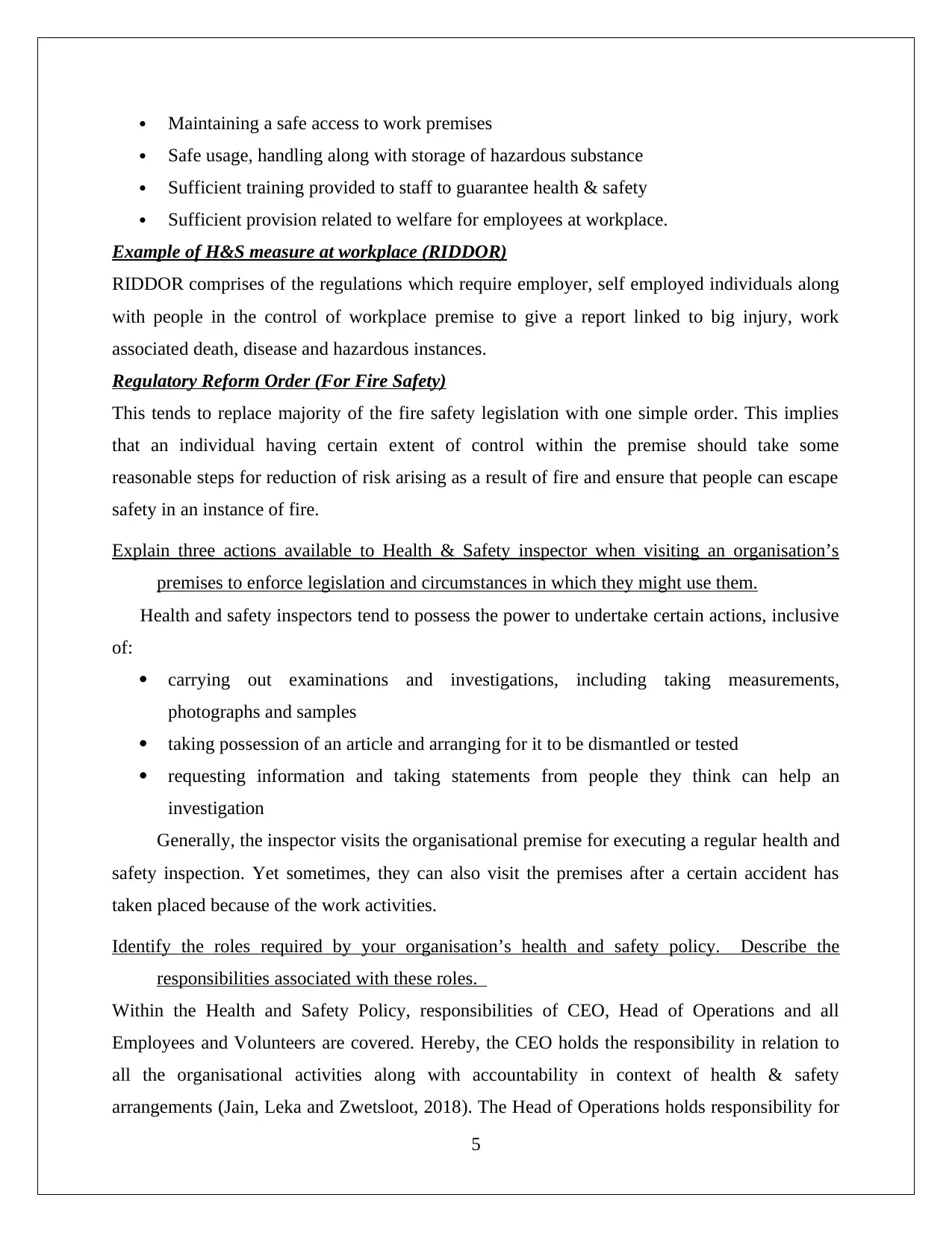
Maintaining a safe access to work premises
Safe usage, handling along with storage of hazardous substance
Sufficient training provided to staff to guarantee health & safety
Sufficient provision related to welfare for employees at workplace.
Example of H&S measure at workplace (RIDDOR)
RIDDOR comprises of the regulations which require employer, self employed individuals along
with people in the control of workplace premise to give a report linked to big injury, work
associated death, disease and hazardous instances.
Regulatory Reform Order (For Fire Safety)
This tends to replace majority of the fire safety legislation with one simple order. This implies
that an individual having certain extent of control within the premise should take some
reasonable steps for reduction of risk arising as a result of fire and ensure that people can escape
safety in an instance of fire.
Explain three actions available to Health & Safety inspector when visiting an organisation’s
premises to enforce legislation and circumstances in which they might use them.
Health and safety inspectors tend to possess the power to undertake certain actions, inclusive
of:
carrying out examinations and investigations, including taking measurements,
photographs and samples
taking possession of an article and arranging for it to be dismantled or tested
requesting information and taking statements from people they think can help an
investigation
Generally, the inspector visits the organisational premise for executing a regular health and
safety inspection. Yet sometimes, they can also visit the premises after a certain accident has
taken placed because of the work activities.
Identify the roles required by your organisation’s health and safety policy. Describe the
responsibilities associated with these roles.
Within the Health and Safety Policy, responsibilities of CEO, Head of Operations and all
Employees and Volunteers are covered. Hereby, the CEO holds the responsibility in relation to
all the organisational activities along with accountability in context of health & safety
arrangements (Jain, Leka and Zwetsloot, 2018). The Head of Operations holds responsibility for
5
Safe usage, handling along with storage of hazardous substance
Sufficient training provided to staff to guarantee health & safety
Sufficient provision related to welfare for employees at workplace.
Example of H&S measure at workplace (RIDDOR)
RIDDOR comprises of the regulations which require employer, self employed individuals along
with people in the control of workplace premise to give a report linked to big injury, work
associated death, disease and hazardous instances.
Regulatory Reform Order (For Fire Safety)
This tends to replace majority of the fire safety legislation with one simple order. This implies
that an individual having certain extent of control within the premise should take some
reasonable steps for reduction of risk arising as a result of fire and ensure that people can escape
safety in an instance of fire.
Explain three actions available to Health & Safety inspector when visiting an organisation’s
premises to enforce legislation and circumstances in which they might use them.
Health and safety inspectors tend to possess the power to undertake certain actions, inclusive
of:
carrying out examinations and investigations, including taking measurements,
photographs and samples
taking possession of an article and arranging for it to be dismantled or tested
requesting information and taking statements from people they think can help an
investigation
Generally, the inspector visits the organisational premise for executing a regular health and
safety inspection. Yet sometimes, they can also visit the premises after a certain accident has
taken placed because of the work activities.
Identify the roles required by your organisation’s health and safety policy. Describe the
responsibilities associated with these roles.
Within the Health and Safety Policy, responsibilities of CEO, Head of Operations and all
Employees and Volunteers are covered. Hereby, the CEO holds the responsibility in relation to
all the organisational activities along with accountability in context of health & safety
arrangements (Jain, Leka and Zwetsloot, 2018). The Head of Operations holds responsibility for
5
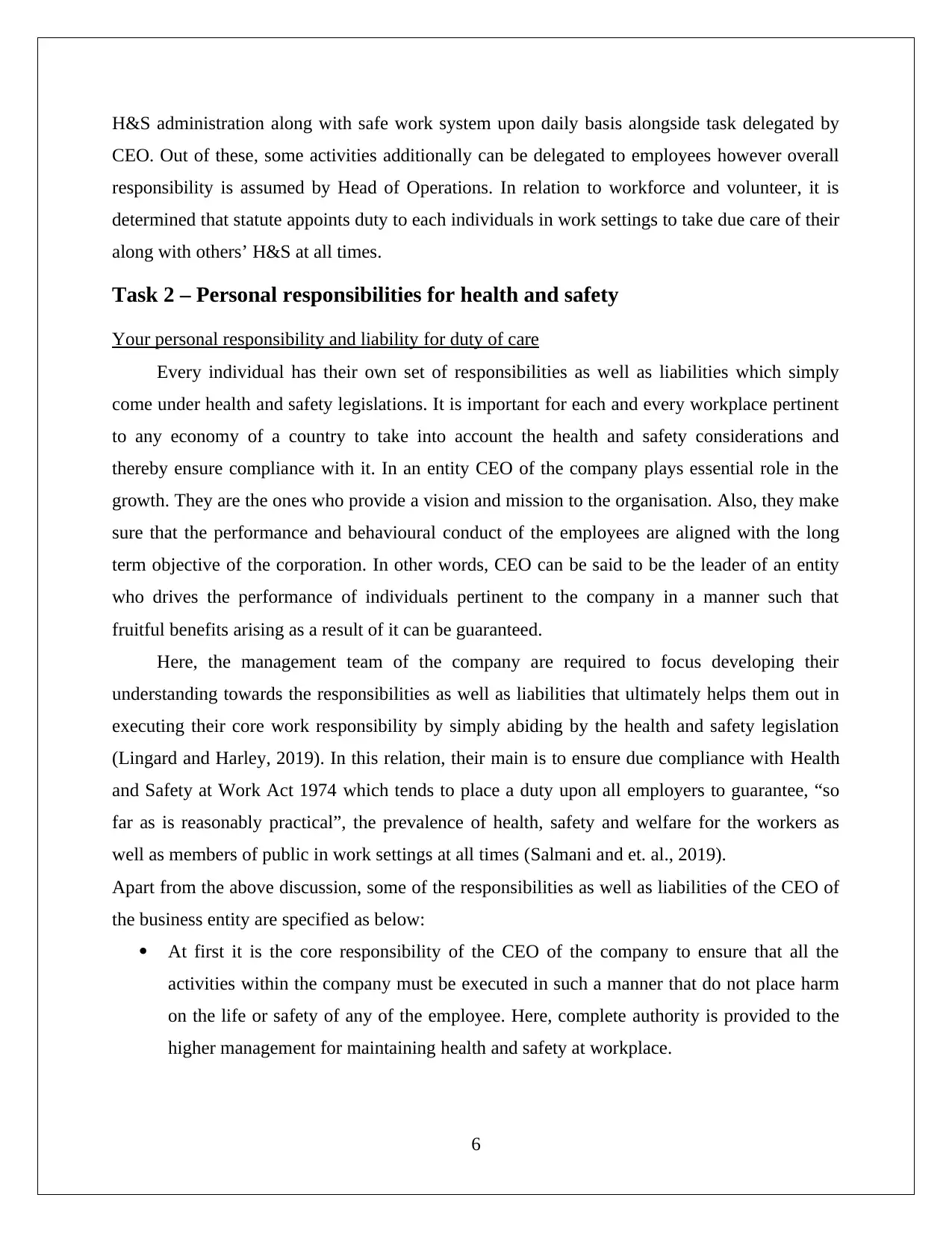
H&S administration along with safe work system upon daily basis alongside task delegated by
CEO. Out of these, some activities additionally can be delegated to employees however overall
responsibility is assumed by Head of Operations. In relation to workforce and volunteer, it is
determined that statute appoints duty to each individuals in work settings to take due care of their
along with others’ H&S at all times.
Task 2 – Personal responsibilities for health and safety
Your personal responsibility and liability for duty of care
Every individual has their own set of responsibilities as well as liabilities which simply
come under health and safety legislations. It is important for each and every workplace pertinent
to any economy of a country to take into account the health and safety considerations and
thereby ensure compliance with it. In an entity CEO of the company plays essential role in the
growth. They are the ones who provide a vision and mission to the organisation. Also, they make
sure that the performance and behavioural conduct of the employees are aligned with the long
term objective of the corporation. In other words, CEO can be said to be the leader of an entity
who drives the performance of individuals pertinent to the company in a manner such that
fruitful benefits arising as a result of it can be guaranteed.
Here, the management team of the company are required to focus developing their
understanding towards the responsibilities as well as liabilities that ultimately helps them out in
executing their core work responsibility by simply abiding by the health and safety legislation
(Lingard and Harley, 2019). In this relation, their main is to ensure due compliance with Health
and Safety at Work Act 1974 which tends to place a duty upon all employers to guarantee, “so
far as is reasonably practical”, the prevalence of health, safety and welfare for the workers as
well as members of public in work settings at all times (Salmani and et. al., 2019).
Apart from the above discussion, some of the responsibilities as well as liabilities of the CEO of
the business entity are specified as below:
At first it is the core responsibility of the CEO of the company to ensure that all the
activities within the company must be executed in such a manner that do not place harm
on the life or safety of any of the employee. Here, complete authority is provided to the
higher management for maintaining health and safety at workplace.
6
CEO. Out of these, some activities additionally can be delegated to employees however overall
responsibility is assumed by Head of Operations. In relation to workforce and volunteer, it is
determined that statute appoints duty to each individuals in work settings to take due care of their
along with others’ H&S at all times.
Task 2 – Personal responsibilities for health and safety
Your personal responsibility and liability for duty of care
Every individual has their own set of responsibilities as well as liabilities which simply
come under health and safety legislations. It is important for each and every workplace pertinent
to any economy of a country to take into account the health and safety considerations and
thereby ensure compliance with it. In an entity CEO of the company plays essential role in the
growth. They are the ones who provide a vision and mission to the organisation. Also, they make
sure that the performance and behavioural conduct of the employees are aligned with the long
term objective of the corporation. In other words, CEO can be said to be the leader of an entity
who drives the performance of individuals pertinent to the company in a manner such that
fruitful benefits arising as a result of it can be guaranteed.
Here, the management team of the company are required to focus developing their
understanding towards the responsibilities as well as liabilities that ultimately helps them out in
executing their core work responsibility by simply abiding by the health and safety legislation
(Lingard and Harley, 2019). In this relation, their main is to ensure due compliance with Health
and Safety at Work Act 1974 which tends to place a duty upon all employers to guarantee, “so
far as is reasonably practical”, the prevalence of health, safety and welfare for the workers as
well as members of public in work settings at all times (Salmani and et. al., 2019).
Apart from the above discussion, some of the responsibilities as well as liabilities of the CEO of
the business entity are specified as below:
At first it is the core responsibility of the CEO of the company to ensure that all the
activities within the company must be executed in such a manner that do not place harm
on the life or safety of any of the employee. Here, complete authority is provided to the
higher management for maintaining health and safety at workplace.
6
⊘ This is a preview!⊘
Do you want full access?
Subscribe today to unlock all pages.

Trusted by 1+ million students worldwide
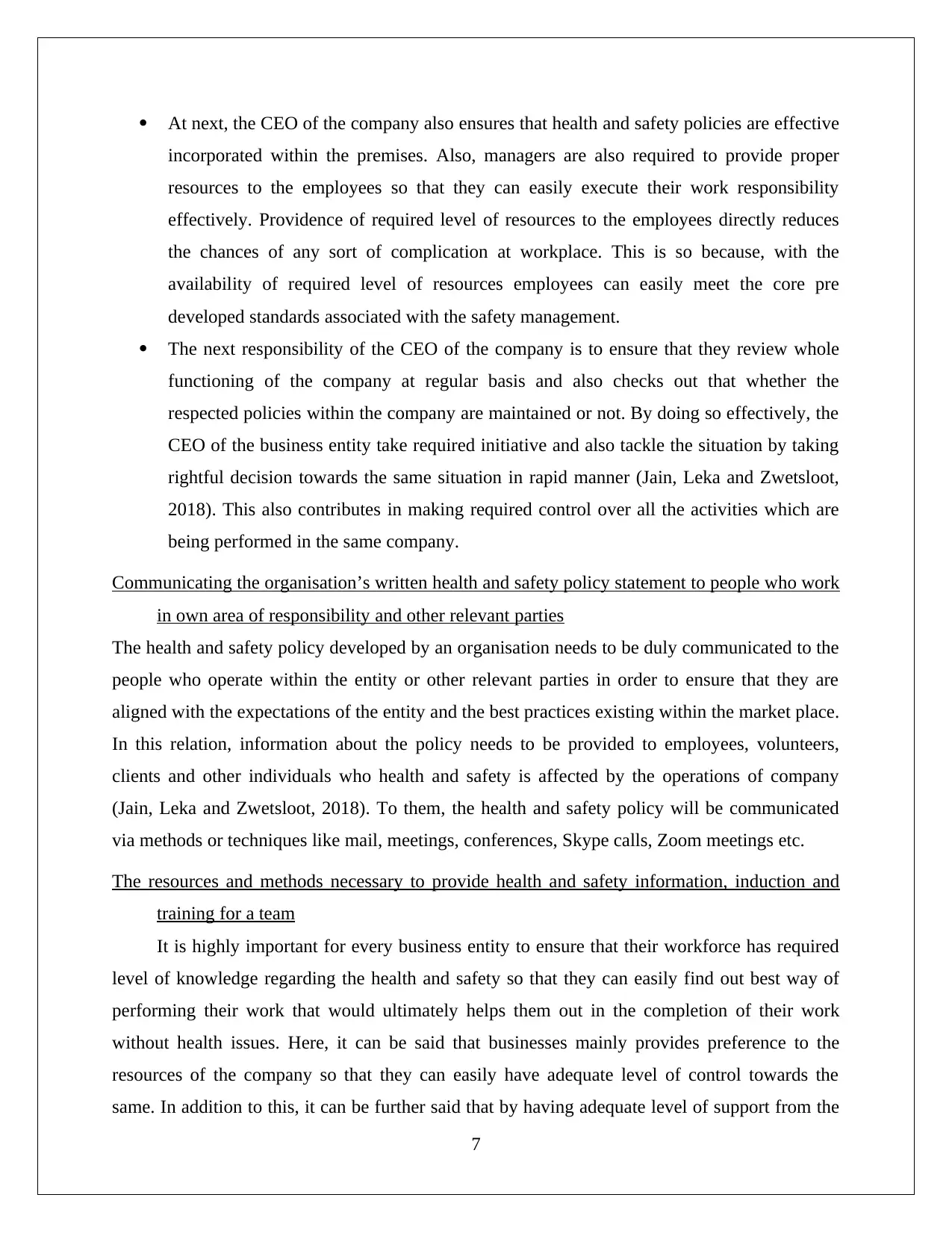
At next, the CEO of the company also ensures that health and safety policies are effective
incorporated within the premises. Also, managers are also required to provide proper
resources to the employees so that they can easily execute their work responsibility
effectively. Providence of required level of resources to the employees directly reduces
the chances of any sort of complication at workplace. This is so because, with the
availability of required level of resources employees can easily meet the core pre
developed standards associated with the safety management.
The next responsibility of the CEO of the company is to ensure that they review whole
functioning of the company at regular basis and also checks out that whether the
respected policies within the company are maintained or not. By doing so effectively, the
CEO of the business entity take required initiative and also tackle the situation by taking
rightful decision towards the same situation in rapid manner (Jain, Leka and Zwetsloot,
2018). This also contributes in making required control over all the activities which are
being performed in the same company.
Communicating the organisation’s written health and safety policy statement to people who work
in own area of responsibility and other relevant parties
The health and safety policy developed by an organisation needs to be duly communicated to the
people who operate within the entity or other relevant parties in order to ensure that they are
aligned with the expectations of the entity and the best practices existing within the market place.
In this relation, information about the policy needs to be provided to employees, volunteers,
clients and other individuals who health and safety is affected by the operations of company
(Jain, Leka and Zwetsloot, 2018). To them, the health and safety policy will be communicated
via methods or techniques like mail, meetings, conferences, Skype calls, Zoom meetings etc.
The resources and methods necessary to provide health and safety information, induction and
training for a team
It is highly important for every business entity to ensure that their workforce has required
level of knowledge regarding the health and safety so that they can easily find out best way of
performing their work that would ultimately helps them out in the completion of their work
without health issues. Here, it can be said that businesses mainly provides preference to the
resources of the company so that they can easily have adequate level of control towards the
same. In addition to this, it can be further said that by having adequate level of support from the
7
incorporated within the premises. Also, managers are also required to provide proper
resources to the employees so that they can easily execute their work responsibility
effectively. Providence of required level of resources to the employees directly reduces
the chances of any sort of complication at workplace. This is so because, with the
availability of required level of resources employees can easily meet the core pre
developed standards associated with the safety management.
The next responsibility of the CEO of the company is to ensure that they review whole
functioning of the company at regular basis and also checks out that whether the
respected policies within the company are maintained or not. By doing so effectively, the
CEO of the business entity take required initiative and also tackle the situation by taking
rightful decision towards the same situation in rapid manner (Jain, Leka and Zwetsloot,
2018). This also contributes in making required control over all the activities which are
being performed in the same company.
Communicating the organisation’s written health and safety policy statement to people who work
in own area of responsibility and other relevant parties
The health and safety policy developed by an organisation needs to be duly communicated to the
people who operate within the entity or other relevant parties in order to ensure that they are
aligned with the expectations of the entity and the best practices existing within the market place.
In this relation, information about the policy needs to be provided to employees, volunteers,
clients and other individuals who health and safety is affected by the operations of company
(Jain, Leka and Zwetsloot, 2018). To them, the health and safety policy will be communicated
via methods or techniques like mail, meetings, conferences, Skype calls, Zoom meetings etc.
The resources and methods necessary to provide health and safety information, induction and
training for a team
It is highly important for every business entity to ensure that their workforce has required
level of knowledge regarding the health and safety so that they can easily find out best way of
performing their work that would ultimately helps them out in the completion of their work
without health issues. Here, it can be said that businesses mainly provides preference to the
resources of the company so that they can easily have adequate level of control towards the
same. In addition to this, it can be further said that by having adequate level of support from the
7
Paraphrase This Document
Need a fresh take? Get an instant paraphrase of this document with our AI Paraphraser
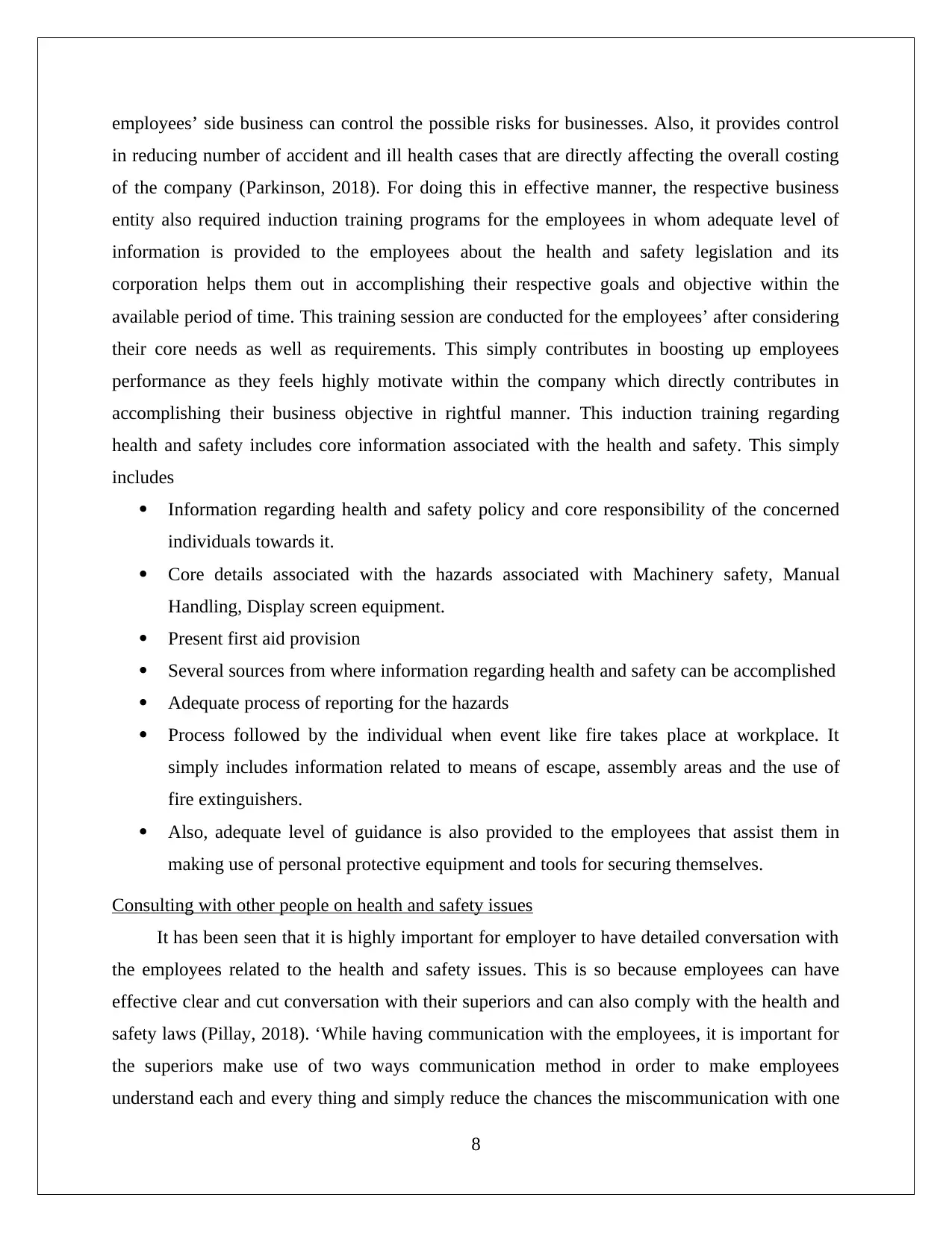
employees’ side business can control the possible risks for businesses. Also, it provides control
in reducing number of accident and ill health cases that are directly affecting the overall costing
of the company (Parkinson, 2018). For doing this in effective manner, the respective business
entity also required induction training programs for the employees in whom adequate level of
information is provided to the employees about the health and safety legislation and its
corporation helps them out in accomplishing their respective goals and objective within the
available period of time. This training session are conducted for the employees’ after considering
their core needs as well as requirements. This simply contributes in boosting up employees
performance as they feels highly motivate within the company which directly contributes in
accomplishing their business objective in rightful manner. This induction training regarding
health and safety includes core information associated with the health and safety. This simply
includes
Information regarding health and safety policy and core responsibility of the concerned
individuals towards it.
Core details associated with the hazards associated with Machinery safety, Manual
Handling, Display screen equipment.
Present first aid provision
Several sources from where information regarding health and safety can be accomplished
Adequate process of reporting for the hazards
Process followed by the individual when event like fire takes place at workplace. It
simply includes information related to means of escape, assembly areas and the use of
fire extinguishers.
Also, adequate level of guidance is also provided to the employees that assist them in
making use of personal protective equipment and tools for securing themselves.
Consulting with other people on health and safety issues
It has been seen that it is highly important for employer to have detailed conversation with
the employees related to the health and safety issues. This is so because employees can have
effective clear and cut conversation with their superiors and can also comply with the health and
safety laws (Pillay, 2018). ‘While having communication with the employees, it is important for
the superiors make use of two ways communication method in order to make employees
understand each and every thing and simply reduce the chances the miscommunication with one
8
in reducing number of accident and ill health cases that are directly affecting the overall costing
of the company (Parkinson, 2018). For doing this in effective manner, the respective business
entity also required induction training programs for the employees in whom adequate level of
information is provided to the employees about the health and safety legislation and its
corporation helps them out in accomplishing their respective goals and objective within the
available period of time. This training session are conducted for the employees’ after considering
their core needs as well as requirements. This simply contributes in boosting up employees
performance as they feels highly motivate within the company which directly contributes in
accomplishing their business objective in rightful manner. This induction training regarding
health and safety includes core information associated with the health and safety. This simply
includes
Information regarding health and safety policy and core responsibility of the concerned
individuals towards it.
Core details associated with the hazards associated with Machinery safety, Manual
Handling, Display screen equipment.
Present first aid provision
Several sources from where information regarding health and safety can be accomplished
Adequate process of reporting for the hazards
Process followed by the individual when event like fire takes place at workplace. It
simply includes information related to means of escape, assembly areas and the use of
fire extinguishers.
Also, adequate level of guidance is also provided to the employees that assist them in
making use of personal protective equipment and tools for securing themselves.
Consulting with other people on health and safety issues
It has been seen that it is highly important for employer to have detailed conversation with
the employees related to the health and safety issues. This is so because employees can have
effective clear and cut conversation with their superiors and can also comply with the health and
safety laws (Pillay, 2018). ‘While having communication with the employees, it is important for
the superiors make use of two ways communication method in order to make employees
understand each and every thing and simply reduce the chances the miscommunication with one
8

another. With reference to my personal experience related to the workplace, it can be said that
the individuals or employees at my own workplace communicated with the superiors related to
the health and safety on the below stated topic.
At first discussion is mainly made on the measures that are required to be taken by
superiors that are affecting employees’ health and safety at workplace.
Appropriate information is provided to the employees regarding the risks associated to
health and safety.
Planning and preparation of any sort of health and safety associated training.
A detailed discussion with the employees on the latest technology incorporation and its
associated with the organisational work.
Here, it can be said that detailed conversation among employer and employees includes
discussion on several norms and regulations which includes the Safety Representatives and
Safety Committees Regulations 1977 and the Health and Safety (Consultation with Employees)
Regulations 1996. This discussion would definitely help employer in dealing with the
circumstances and applying all rules and regulations related to health safety at workplace in
rightful manner (McCalman and et. al., 2020). In order to do effectively appropriate application
of the regulations must be done within the company. In addition to this, the required discussion
must also be made on training standards that are required to be adhered in the company in
rightful manner.
Using health and safety to inform planning and decision-making
The compliance with Health and safety regulations isn't just a subject of legitimate need,
it tends to inflate the confidence of workers and advance an association's repute for being a
decent employer (Willmer and Haas, 2016). It tends to account as a proof of its CSR efforts or
initiatives. Within the bounds of numerous associations, facilities manager along with
individuals pertinent to the team possess the essential obligation regarding the administration of
health and safety in the interest of its senior administration. The essential source for health and
safety direction within the working scenario of an organisation is Health and Safety Executive
(HSE). Health and safety monitors from HSE hold the ability of entering the premises of an
organisation even without any kind of notice for authorizing enactment. A governmental body
assuming the responsibility to ensure that all kind of health and safety laws and regulations are
implemented and enacted at workplace is referred to as The Health and Safety Executive (HSE).
9
the individuals or employees at my own workplace communicated with the superiors related to
the health and safety on the below stated topic.
At first discussion is mainly made on the measures that are required to be taken by
superiors that are affecting employees’ health and safety at workplace.
Appropriate information is provided to the employees regarding the risks associated to
health and safety.
Planning and preparation of any sort of health and safety associated training.
A detailed discussion with the employees on the latest technology incorporation and its
associated with the organisational work.
Here, it can be said that detailed conversation among employer and employees includes
discussion on several norms and regulations which includes the Safety Representatives and
Safety Committees Regulations 1977 and the Health and Safety (Consultation with Employees)
Regulations 1996. This discussion would definitely help employer in dealing with the
circumstances and applying all rules and regulations related to health safety at workplace in
rightful manner (McCalman and et. al., 2020). In order to do effectively appropriate application
of the regulations must be done within the company. In addition to this, the required discussion
must also be made on training standards that are required to be adhered in the company in
rightful manner.
Using health and safety to inform planning and decision-making
The compliance with Health and safety regulations isn't just a subject of legitimate need,
it tends to inflate the confidence of workers and advance an association's repute for being a
decent employer (Willmer and Haas, 2016). It tends to account as a proof of its CSR efforts or
initiatives. Within the bounds of numerous associations, facilities manager along with
individuals pertinent to the team possess the essential obligation regarding the administration of
health and safety in the interest of its senior administration. The essential source for health and
safety direction within the working scenario of an organisation is Health and Safety Executive
(HSE). Health and safety monitors from HSE hold the ability of entering the premises of an
organisation even without any kind of notice for authorizing enactment. A governmental body
assuming the responsibility to ensure that all kind of health and safety laws and regulations are
implemented and enacted at workplace is referred to as The Health and Safety Executive (HSE).
9
⊘ This is a preview!⊘
Do you want full access?
Subscribe today to unlock all pages.

Trusted by 1+ million students worldwide
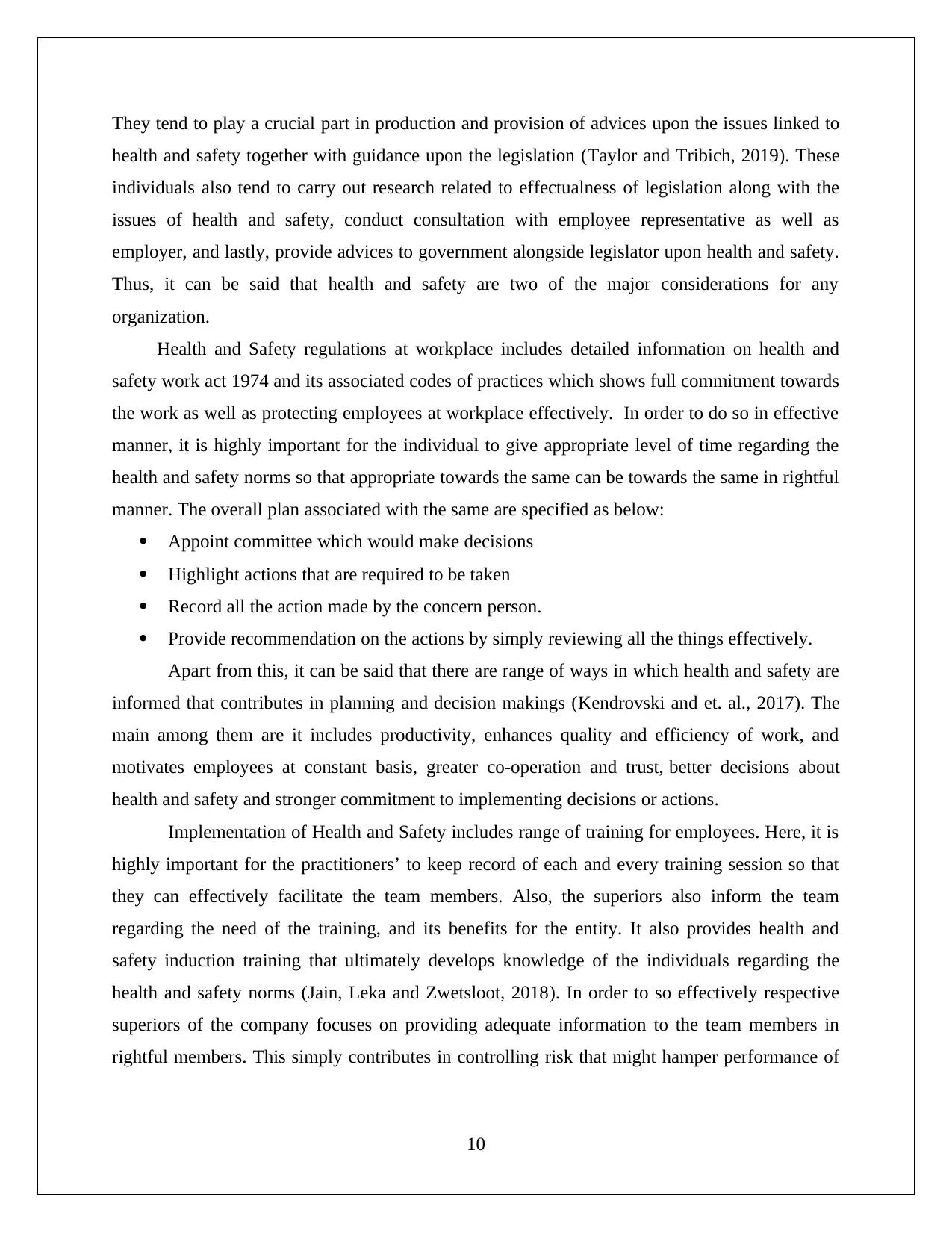
They tend to play a crucial part in production and provision of advices upon the issues linked to
health and safety together with guidance upon the legislation (Taylor and Tribich, 2019). These
individuals also tend to carry out research related to effectualness of legislation along with the
issues of health and safety, conduct consultation with employee representative as well as
employer, and lastly, provide advices to government alongside legislator upon health and safety.
Thus, it can be said that health and safety are two of the major considerations for any
organization.
Health and Safety regulations at workplace includes detailed information on health and
safety work act 1974 and its associated codes of practices which shows full commitment towards
the work as well as protecting employees at workplace effectively. In order to do so in effective
manner, it is highly important for the individual to give appropriate level of time regarding the
health and safety norms so that appropriate towards the same can be towards the same in rightful
manner. The overall plan associated with the same are specified as below:
Appoint committee which would make decisions
Highlight actions that are required to be taken
Record all the action made by the concern person.
Provide recommendation on the actions by simply reviewing all the things effectively.
Apart from this, it can be said that there are range of ways in which health and safety are
informed that contributes in planning and decision makings (Kendrovski and et. al., 2017). The
main among them are it includes productivity, enhances quality and efficiency of work, and
motivates employees at constant basis, greater co-operation and trust, better decisions about
health and safety and stronger commitment to implementing decisions or actions.
Implementation of Health and Safety includes range of training for employees. Here, it is
highly important for the practitioners’ to keep record of each and every training session so that
they can effectively facilitate the team members. Also, the superiors also inform the team
regarding the need of the training, and its benefits for the entity. It also provides health and
safety induction training that ultimately develops knowledge of the individuals regarding the
health and safety norms (Jain, Leka and Zwetsloot, 2018). In order to so effectively respective
superiors of the company focuses on providing adequate information to the team members in
rightful members. This simply contributes in controlling risk that might hamper performance of
10
health and safety together with guidance upon the legislation (Taylor and Tribich, 2019). These
individuals also tend to carry out research related to effectualness of legislation along with the
issues of health and safety, conduct consultation with employee representative as well as
employer, and lastly, provide advices to government alongside legislator upon health and safety.
Thus, it can be said that health and safety are two of the major considerations for any
organization.
Health and Safety regulations at workplace includes detailed information on health and
safety work act 1974 and its associated codes of practices which shows full commitment towards
the work as well as protecting employees at workplace effectively. In order to do so in effective
manner, it is highly important for the individual to give appropriate level of time regarding the
health and safety norms so that appropriate towards the same can be towards the same in rightful
manner. The overall plan associated with the same are specified as below:
Appoint committee which would make decisions
Highlight actions that are required to be taken
Record all the action made by the concern person.
Provide recommendation on the actions by simply reviewing all the things effectively.
Apart from this, it can be said that there are range of ways in which health and safety are
informed that contributes in planning and decision makings (Kendrovski and et. al., 2017). The
main among them are it includes productivity, enhances quality and efficiency of work, and
motivates employees at constant basis, greater co-operation and trust, better decisions about
health and safety and stronger commitment to implementing decisions or actions.
Implementation of Health and Safety includes range of training for employees. Here, it is
highly important for the practitioners’ to keep record of each and every training session so that
they can effectively facilitate the team members. Also, the superiors also inform the team
regarding the need of the training, and its benefits for the entity. It also provides health and
safety induction training that ultimately develops knowledge of the individuals regarding the
health and safety norms (Jain, Leka and Zwetsloot, 2018). In order to so effectively respective
superiors of the company focuses on providing adequate information to the team members in
rightful members. This simply contributes in controlling risk that might hamper performance of
10
Paraphrase This Document
Need a fresh take? Get an instant paraphrase of this document with our AI Paraphraser
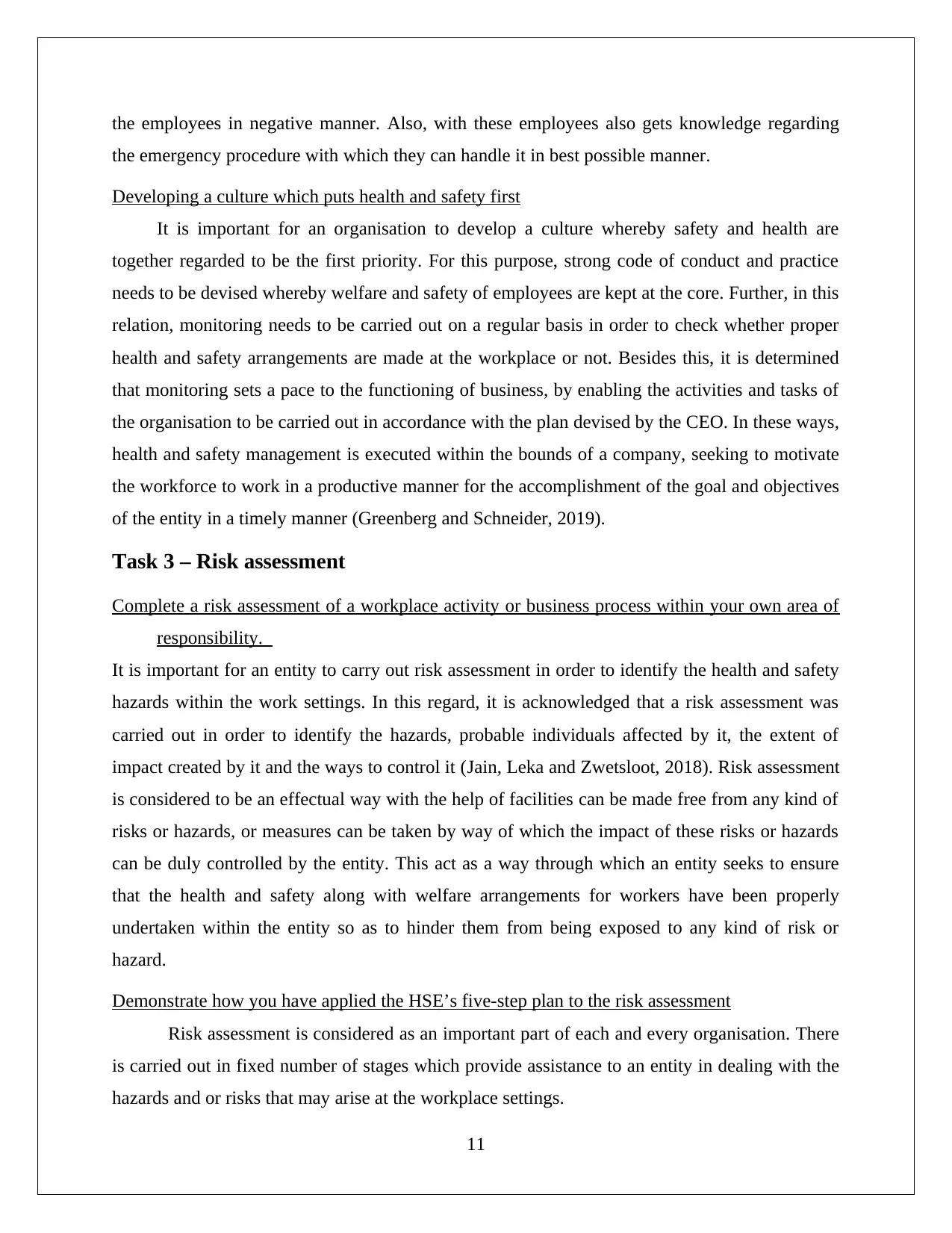
the employees in negative manner. Also, with these employees also gets knowledge regarding
the emergency procedure with which they can handle it in best possible manner.
Developing a culture which puts health and safety first
It is important for an organisation to develop a culture whereby safety and health are
together regarded to be the first priority. For this purpose, strong code of conduct and practice
needs to be devised whereby welfare and safety of employees are kept at the core. Further, in this
relation, monitoring needs to be carried out on a regular basis in order to check whether proper
health and safety arrangements are made at the workplace or not. Besides this, it is determined
that monitoring sets a pace to the functioning of business, by enabling the activities and tasks of
the organisation to be carried out in accordance with the plan devised by the CEO. In these ways,
health and safety management is executed within the bounds of a company, seeking to motivate
the workforce to work in a productive manner for the accomplishment of the goal and objectives
of the entity in a timely manner (Greenberg and Schneider, 2019).
Task 3 – Risk assessment
Complete a risk assessment of a workplace activity or business process within your own area of
responsibility.
It is important for an entity to carry out risk assessment in order to identify the health and safety
hazards within the work settings. In this regard, it is acknowledged that a risk assessment was
carried out in order to identify the hazards, probable individuals affected by it, the extent of
impact created by it and the ways to control it (Jain, Leka and Zwetsloot, 2018). Risk assessment
is considered to be an effectual way with the help of facilities can be made free from any kind of
risks or hazards, or measures can be taken by way of which the impact of these risks or hazards
can be duly controlled by the entity. This act as a way through which an entity seeks to ensure
that the health and safety along with welfare arrangements for workers have been properly
undertaken within the entity so as to hinder them from being exposed to any kind of risk or
hazard.
Demonstrate how you have applied the HSE’s five-step plan to the risk assessment
Risk assessment is considered as an important part of each and every organisation. There
is carried out in fixed number of stages which provide assistance to an entity in dealing with the
hazards and or risks that may arise at the workplace settings.
11
the emergency procedure with which they can handle it in best possible manner.
Developing a culture which puts health and safety first
It is important for an organisation to develop a culture whereby safety and health are
together regarded to be the first priority. For this purpose, strong code of conduct and practice
needs to be devised whereby welfare and safety of employees are kept at the core. Further, in this
relation, monitoring needs to be carried out on a regular basis in order to check whether proper
health and safety arrangements are made at the workplace or not. Besides this, it is determined
that monitoring sets a pace to the functioning of business, by enabling the activities and tasks of
the organisation to be carried out in accordance with the plan devised by the CEO. In these ways,
health and safety management is executed within the bounds of a company, seeking to motivate
the workforce to work in a productive manner for the accomplishment of the goal and objectives
of the entity in a timely manner (Greenberg and Schneider, 2019).
Task 3 – Risk assessment
Complete a risk assessment of a workplace activity or business process within your own area of
responsibility.
It is important for an entity to carry out risk assessment in order to identify the health and safety
hazards within the work settings. In this regard, it is acknowledged that a risk assessment was
carried out in order to identify the hazards, probable individuals affected by it, the extent of
impact created by it and the ways to control it (Jain, Leka and Zwetsloot, 2018). Risk assessment
is considered to be an effectual way with the help of facilities can be made free from any kind of
risks or hazards, or measures can be taken by way of which the impact of these risks or hazards
can be duly controlled by the entity. This act as a way through which an entity seeks to ensure
that the health and safety along with welfare arrangements for workers have been properly
undertaken within the entity so as to hinder them from being exposed to any kind of risk or
hazard.
Demonstrate how you have applied the HSE’s five-step plan to the risk assessment
Risk assessment is considered as an important part of each and every organisation. There
is carried out in fixed number of stages which provide assistance to an entity in dealing with the
hazards and or risks that may arise at the workplace settings.
11
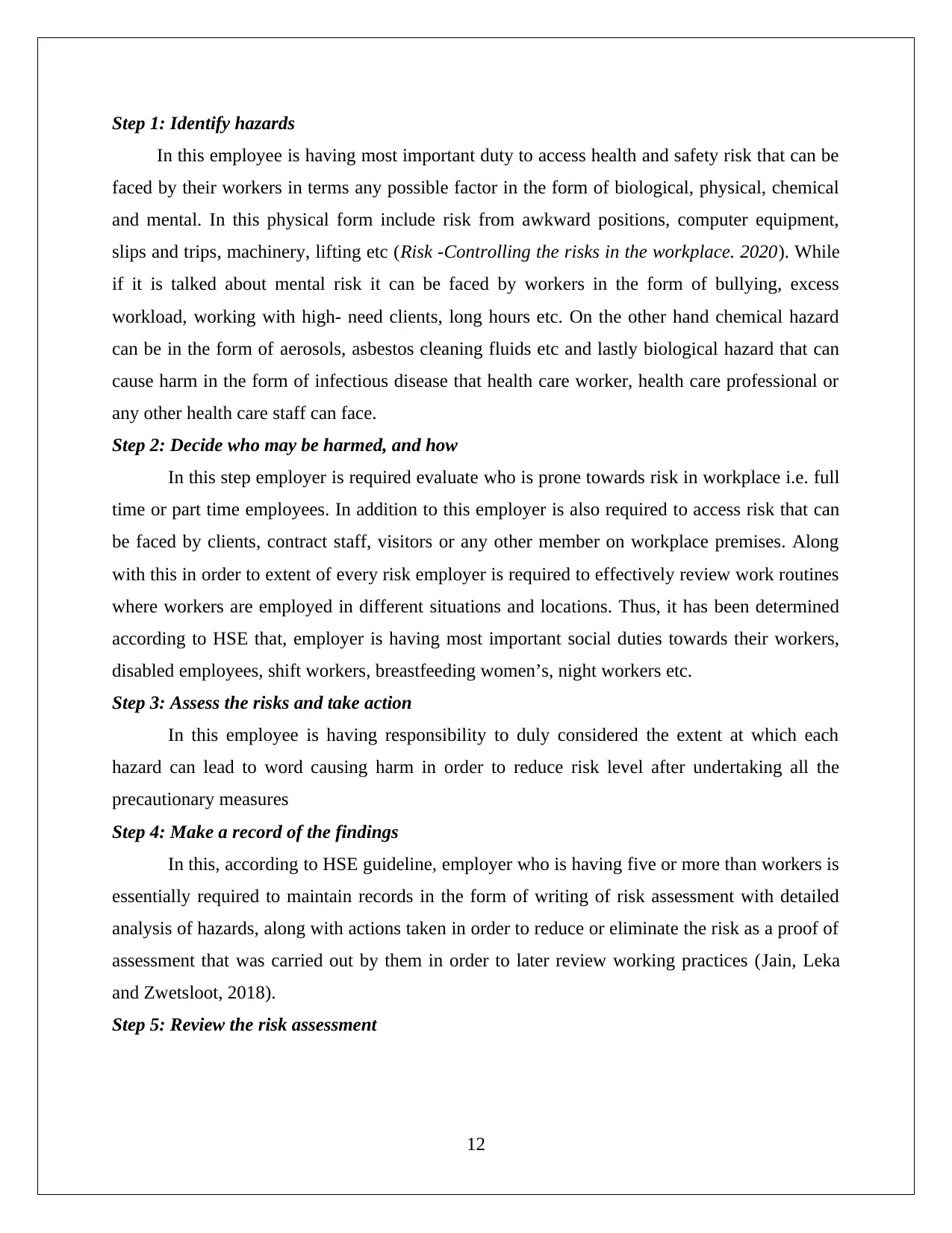
Step 1: Identify hazards
In this employee is having most important duty to access health and safety risk that can be
faced by their workers in terms any possible factor in the form of biological, physical, chemical
and mental. In this physical form include risk from awkward positions, computer equipment,
slips and trips, machinery, lifting etc (Risk -Controlling the risks in the workplace. 2020). While
if it is talked about mental risk it can be faced by workers in the form of bullying, excess
workload, working with high- need clients, long hours etc. On the other hand chemical hazard
can be in the form of aerosols, asbestos cleaning fluids etc and lastly biological hazard that can
cause harm in the form of infectious disease that health care worker, health care professional or
any other health care staff can face.
Step 2: Decide who may be harmed, and how
In this step employer is required evaluate who is prone towards risk in workplace i.e. full
time or part time employees. In addition to this employer is also required to access risk that can
be faced by clients, contract staff, visitors or any other member on workplace premises. Along
with this in order to extent of every risk employer is required to effectively review work routines
where workers are employed in different situations and locations. Thus, it has been determined
according to HSE that, employer is having most important social duties towards their workers,
disabled employees, shift workers, breastfeeding women’s, night workers etc.
Step 3: Assess the risks and take action
In this employee is having responsibility to duly considered the extent at which each
hazard can lead to word causing harm in order to reduce risk level after undertaking all the
precautionary measures
Step 4: Make a record of the findings
In this, according to HSE guideline, employer who is having five or more than workers is
essentially required to maintain records in the form of writing of risk assessment with detailed
analysis of hazards, along with actions taken in order to reduce or eliminate the risk as a proof of
assessment that was carried out by them in order to later review working practices (Jain, Leka
and Zwetsloot, 2018).
Step 5: Review the risk assessment
12
In this employee is having most important duty to access health and safety risk that can be
faced by their workers in terms any possible factor in the form of biological, physical, chemical
and mental. In this physical form include risk from awkward positions, computer equipment,
slips and trips, machinery, lifting etc (Risk -Controlling the risks in the workplace. 2020). While
if it is talked about mental risk it can be faced by workers in the form of bullying, excess
workload, working with high- need clients, long hours etc. On the other hand chemical hazard
can be in the form of aerosols, asbestos cleaning fluids etc and lastly biological hazard that can
cause harm in the form of infectious disease that health care worker, health care professional or
any other health care staff can face.
Step 2: Decide who may be harmed, and how
In this step employer is required evaluate who is prone towards risk in workplace i.e. full
time or part time employees. In addition to this employer is also required to access risk that can
be faced by clients, contract staff, visitors or any other member on workplace premises. Along
with this in order to extent of every risk employer is required to effectively review work routines
where workers are employed in different situations and locations. Thus, it has been determined
according to HSE that, employer is having most important social duties towards their workers,
disabled employees, shift workers, breastfeeding women’s, night workers etc.
Step 3: Assess the risks and take action
In this employee is having responsibility to duly considered the extent at which each
hazard can lead to word causing harm in order to reduce risk level after undertaking all the
precautionary measures
Step 4: Make a record of the findings
In this, according to HSE guideline, employer who is having five or more than workers is
essentially required to maintain records in the form of writing of risk assessment with detailed
analysis of hazards, along with actions taken in order to reduce or eliminate the risk as a proof of
assessment that was carried out by them in order to later review working practices (Jain, Leka
and Zwetsloot, 2018).
Step 5: Review the risk assessment
12
⊘ This is a preview!⊘
Do you want full access?
Subscribe today to unlock all pages.

Trusted by 1+ million students worldwide
1 out of 19
Your All-in-One AI-Powered Toolkit for Academic Success.
+13062052269
info@desklib.com
Available 24*7 on WhatsApp / Email
![[object Object]](/_next/static/media/star-bottom.7253800d.svg)
Unlock your academic potential
Copyright © 2020–2025 A2Z Services. All Rights Reserved. Developed and managed by ZUCOL.